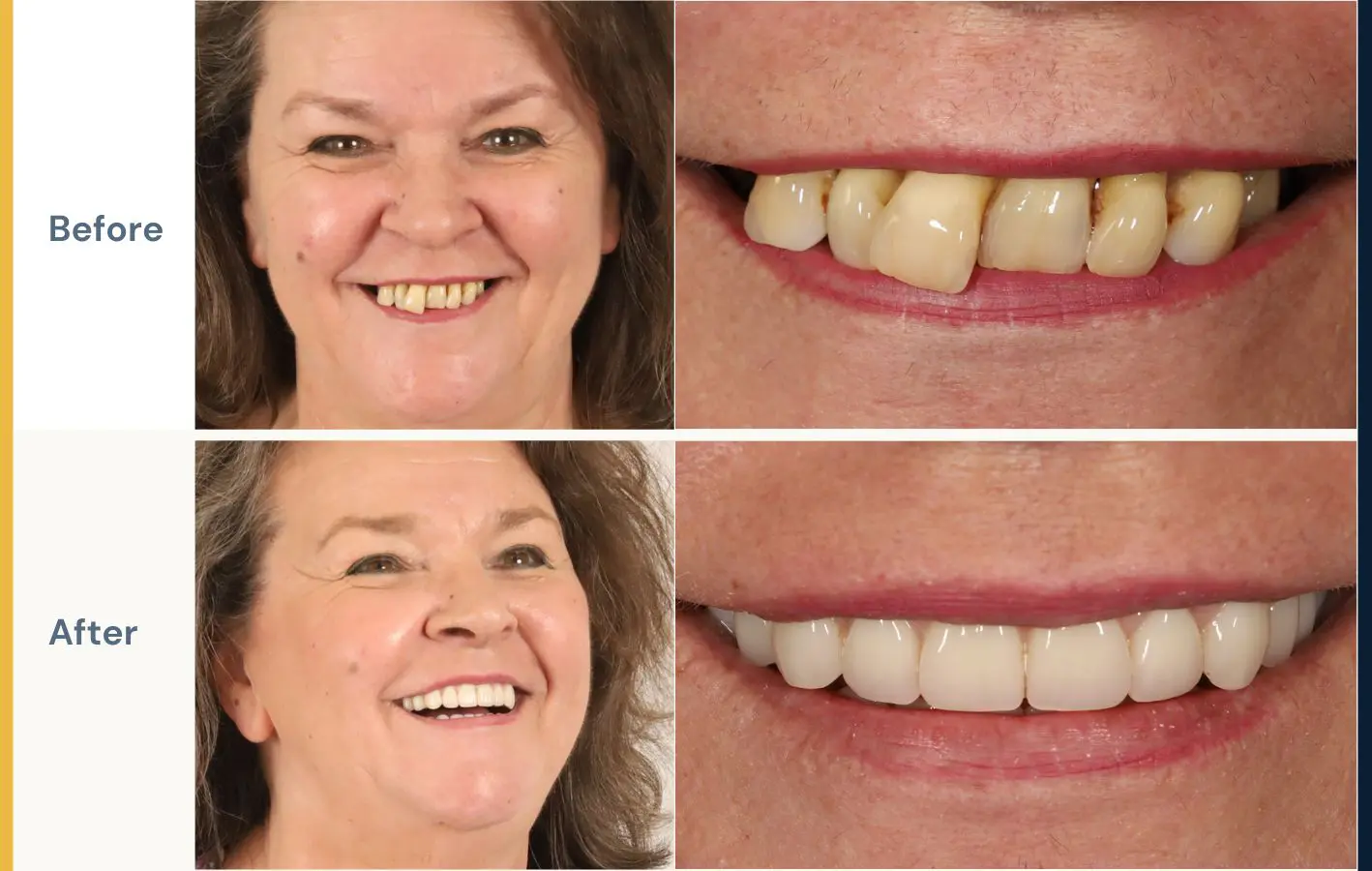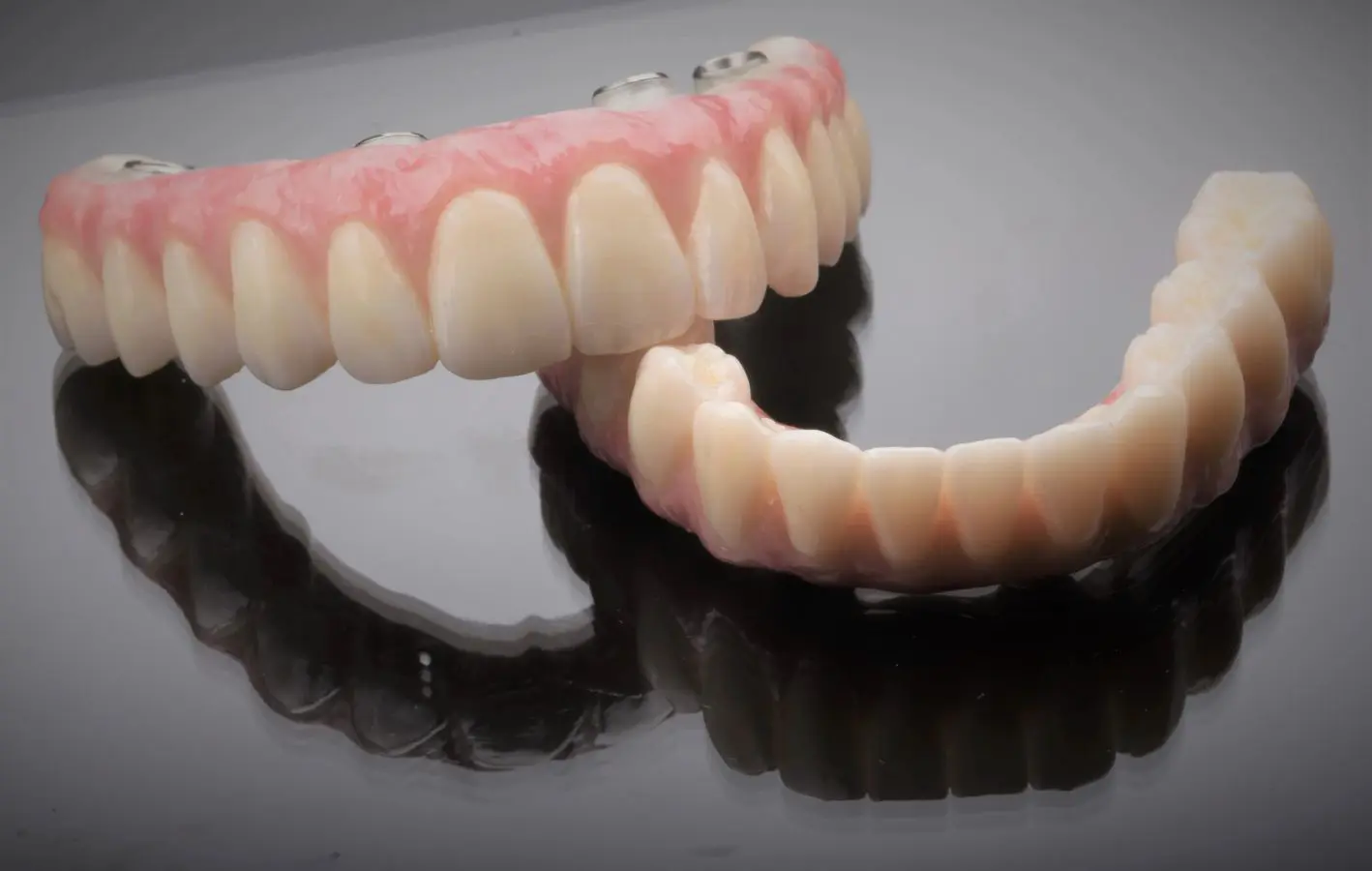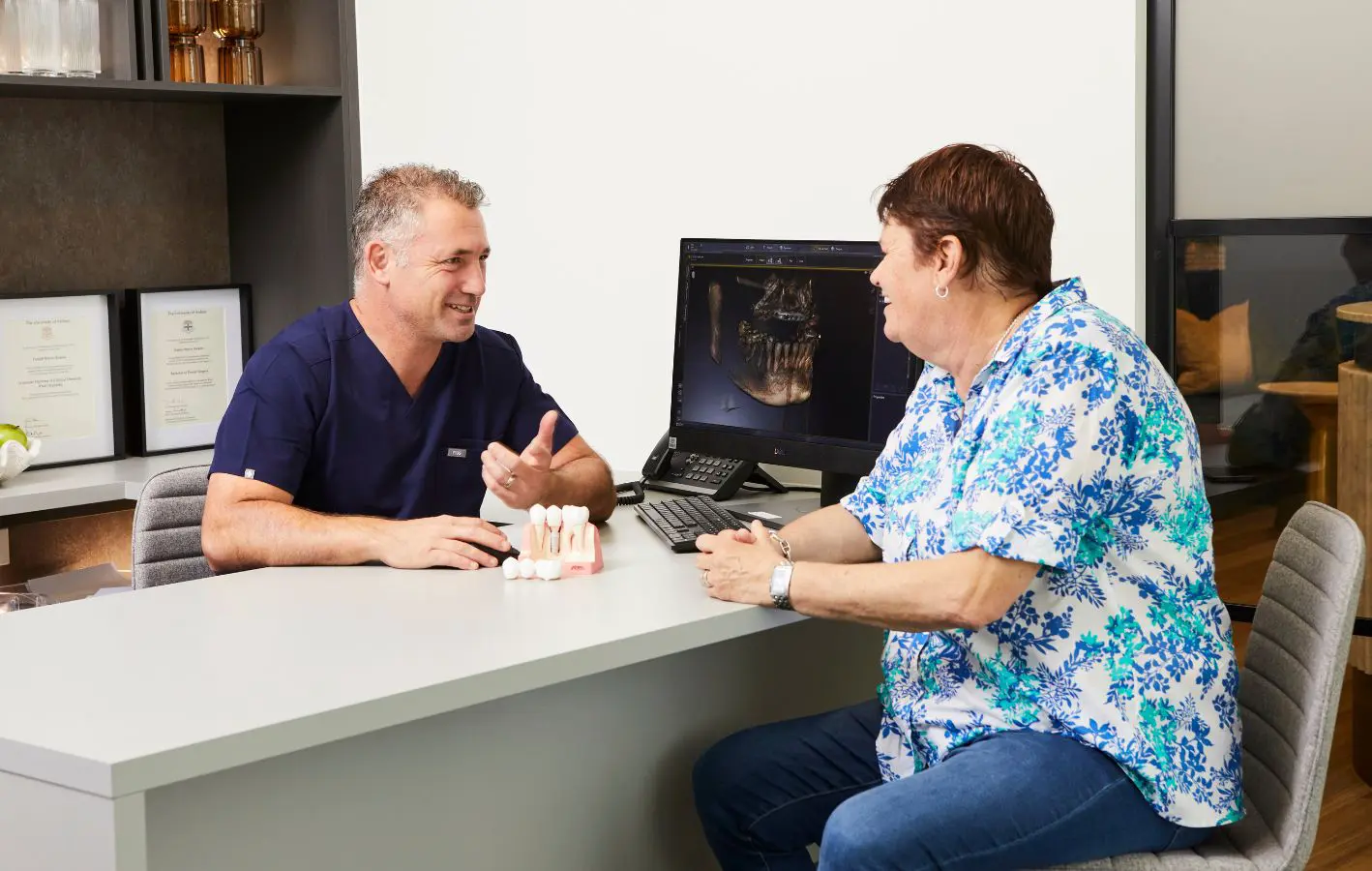
BDS Dip. Clin Dent (Oral Implants), University of Sydney.
Clinical Director at Dental Implants on Miller, with over 25+ years experience in dental implants.

Considering replacing missing or damaged teeth, or finally saying goodbye to uncomfortable dentures? Then you’ve probably asked yourself, ‘what is all-on-4?’ Put simply:
All-on-4 dental implants are a full-arch tooth replacement treatment that uses just four strategically-placed dental implants to support a fixed bridge of new teeth.
Unlike removable dentures, All-on-4 dental implants provide a stable, natural-looking set of fixed teeth, restoring chewing function, confidence, and comfort. In many cases, patients can receive their dental implants and walk out with a new set of teeth in as little as 1–5 days.
In this article, we’ll explain what All-on-4 dental implants are, how the procedure works, the benefits and limitations, and what you can expect if you’re considering this life-changing treatment.

All-on-4 is designed to replace a full arch of damaged or missing teeth in the upper or lower jaw, using just four implants. Two dental implants are strategically positioned at the front of the jaw in a straight alignment, and two dental implants are placed at the back at a 45-degree angle. This angled placement helps overcome bone deficiencies and makes the most of the existing bone density — often avoiding the need for bone grafting.
Specialised multi-unit abutments are used to secure the tilted dental implants and create a stable foundation for the new teeth. This stability allows a reinforced implant bridge to be attached soon after surgery, using tiny screws to fix it securely onto the titanium implants.
In most cases, you can get all your teeth replaced in the upper or lower jaw in a single day. It involves the placement of the implants, fitting of a temporary set of prosthetic teeth, and later, the delivery of the final, permanent teeth once healing has taken place.
The result is immediate improvements in smile function, appearance, and speech, as well as a boost in confidence and self-esteem. Unlike removable dentures, All-on-4 offers a long-term, fixed solution that feels and functions like natural teeth.
Did you know? The All-on-4 concept was developed by Dr Paulo Malo in Portugal in the 1990s. It has since become a globally recognised standard in full arch rehabilitation.
While the All-on-4 dental implants procedure steps are complex and need careful planning, the surgery itself is relatively quick and straightforward. Here’s a guide to the All-on-4 procedure step by step.
During the consultation, your implant dentist will examine your mouth, take x-rays and 3D scans of your teeth and jaw to assess your suitability for treatment. Special software is used to plan the accurate placement of your dental implants.
To ensure you feel relaxed and at ease, the procedure is carried out under twilight sedation. If needed, existing teeth will be removed. Your dental implants are surgically placed into your jaw. It typically takes between 3 to 4 hours to secure the implants into each jaw.
Most patients receive their tooth bridge in as little as 1-3 days after implant surgery. This initial acrylic tooth bridge is designed to be worn for approximately 3 to 6 months while the jawbone and gums completely heal.
Those who have opted for a two-bridge solution will return once healing is complete. An upgraded tooth bridge will be fitted. Typically, the bridge is made from titanium or zirconia, which are stronger and have a longer lifespan than the acrylic version.

No, at Dental Implants on Miller, the All on 4 procedure is carried out under twilight sedation (also known as IV sedation). Twilight sedation relaxes the body’s central nervous system, sending you into a calm, sleep-like state. With this type of sleep dentistry, you will remain conscious and responsive but you’ll be less reactive to what’s happening around you.
After your treatment, you will spend around an hour or two in our state-of-the-art recovery rooms as the anaesthesia wears off. Due to the amnesic effect of sedation, you may have very little or no memory of your procedure at all. Keep in mind that you will need a family member, partner or friend to escort you home after surgery as you won’t be able to drive.
Twilight sedation helps to suppress your pain receptors, so you won’t feel any pain or discomfort during your All on 4 dental implants procedure.
As with any surgery, you can expect some discomfort, swelling and/or bruising in the days following your All-on-4 procedure. We will issue you with prescription painkillers to help you minimise any discomfort during this time.
For most patients, the All-on-4 recovery period is quicker than expected. Generally, people can resume normal activities within 10 to 14 days. By following your All-on-4 post-op aftercare instructions you can support optimum healing.
This includes:
No time to be without teeth? No worries! With All-on-4, you can completely restore your smile in as little as 1 to 3 days.

Forget about loose, uncomfortable dentures — All-on-4 provides you with a permanently fixed set of up to 12 replacement teeth, with success rates of 95-98%
While bone grafts are common and often necessary with traditional dental implants, All-on-4 reduces the need for this.
All-on-4 dental implants function just like your natural teeth so you can enjoy the ability to eat, speak, laugh and smile freely again.
Hand-crafted to look just like the real thing, All-on-4 dental implants will give you a beautiful, natural smile.
No longer feel embarrassed or ashamed of your teeth. With All-on-4, you don’t just get your smile back — you get your life back.

While the All-on-4 dental implant procedure is a life-changing solution for many patients, there are pros and cons to All-on-4. Some potential downsides to consider:
The procedure involves removing failing teeth and, in some cases, reshaping bone or gum tissue, which is permanent.
Acrylic bridges may need replacing every 5 years or so due to wear, staining, or breakage. Zirconia bridges last longer but come at a higher cost.
Some patients find it takes time to adapt to speaking and eating with a fixed bridge, especially if they’ve been used to dentures.
Though success rates are high (95–98%), implants can occasionally fail. This may require removal, healing time, and replacement.
Patients with uncontrolled medical conditions, active gum disease, or insufficient bone in some areas may need additional treatment before the All-on-4 procedure.
The good news is that with the right planning, experienced implant dentist, and ongoing care, most patients enjoy decades of reliable function and a natural-looking smile with All-on-4.
All-on-4 cost varies, with the average cost of All-on-4 treatment in Australia costing between $23,000 to $27,000 per arch. This price variation is due to multiple factors.
Factors that affect the price of All-on-4 treatment include:
Premium, clinically proven implants and abutments, such as those from Nobel Biocare, come at a higher price point.
Acrylic is usually the most affordable, while zirconia or titanium cost more but last longer.
Additional procedures like extractions, bone grafting, or soft tissue work can add to the total.
Highly experienced implant dentists may charge more, but this often reflects greater precision and success rates.
Clinics that invest in advanced digital planning and guided surgery often achieve better outcomes, which can influence cost.
Ongoing reviews, adjustments, and long-term support are usually factored into treatment fees.
Many all-on-4 clinics offer loans or interest-free payment plans to help patients cover the costs more easily. Explore our finance options and don’t forget, you may be eligible to access your superannuation for your All-on-4 treatment.

All-on-4 dental implants are designed to be a long-term solution — often lasting decades, or even a lifetime, with proper care. The titanium implants placed in your jaw can remain healthy and functional as long as your jawbone is stable.
It’s rare, but in some cases the body may reject an implant. If this happens, new implants can usually be placed after a healing period.
The tooth bridge material you choose also impacts longevity:
For a smile to last a lifetime, you need to ensure proper care and cleaning of your All-on-4 dental implants and tooth bridges.
This includes:

If you’re wondering who is suitable for All-on-4 dental implants, the treatment is generally recommended for patients missing most or all of their teeth, with good oral and general health.
This includes cases where a patient is/has:
The best way to determine if All-on-4 dental implants are right for you is to book a free consultation with Dr Adamo. During your free consultation, Dr Adamo will assess your oral health, take x-rays to check your jaw bone and gums, and discuss the most appropriate treatment options for you.
Dr Adamo graduated with a Bachelor of Dental Science from the University of Sydney, then went on to complete his post-graduate education in dental implants, receiving a Graduate Diploma in Clinical Dentistry (Oral Implants). He has over 25 years of experience and has restored thousands of smiles with dental implants and All-on-4, so you know you’re in safe and trusted hands at Dental Implants on Miller.


